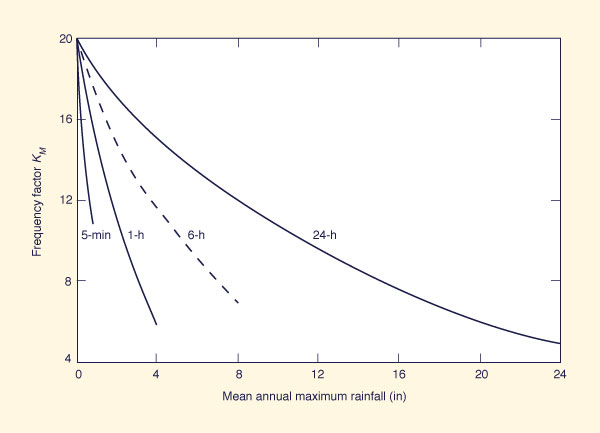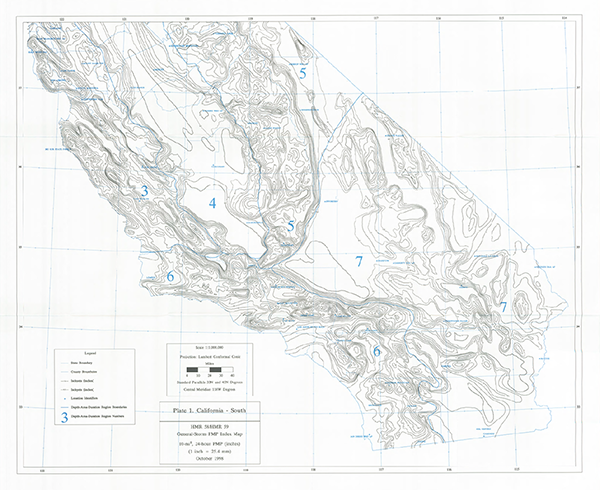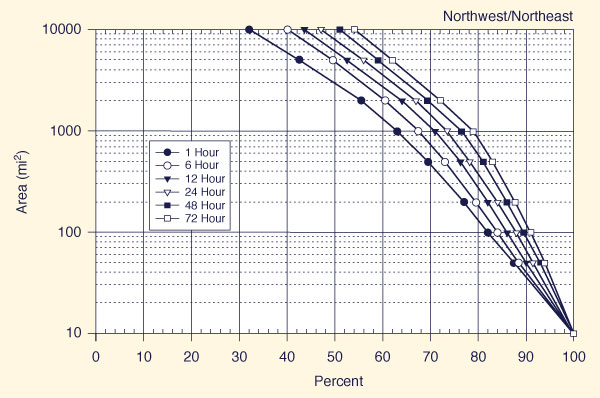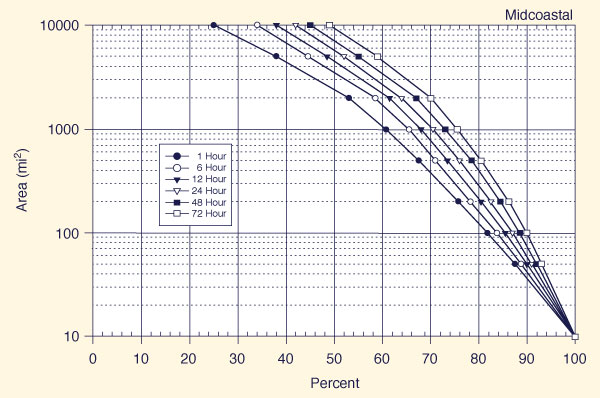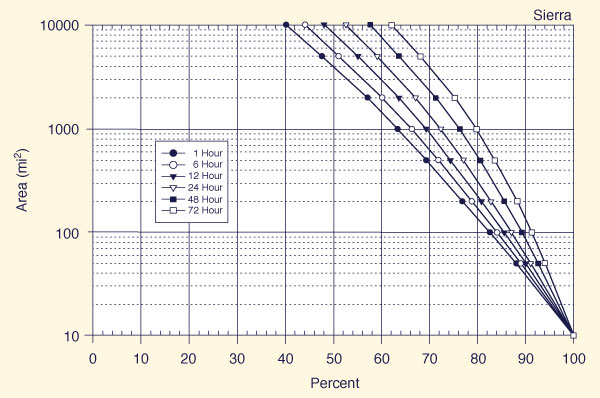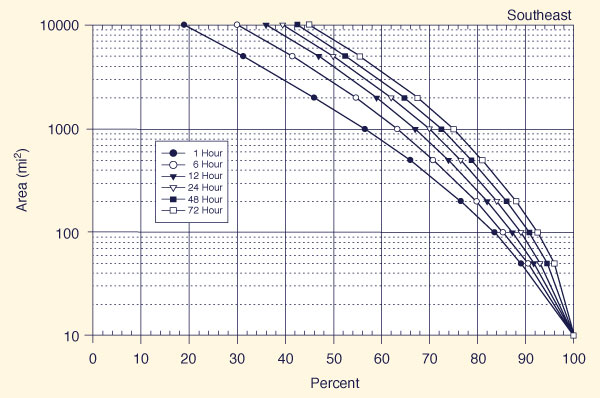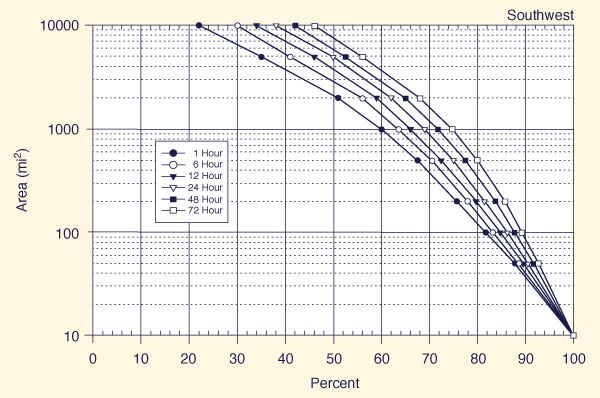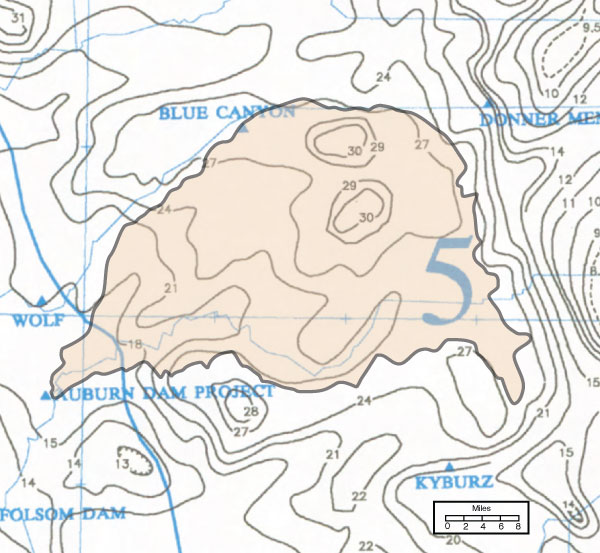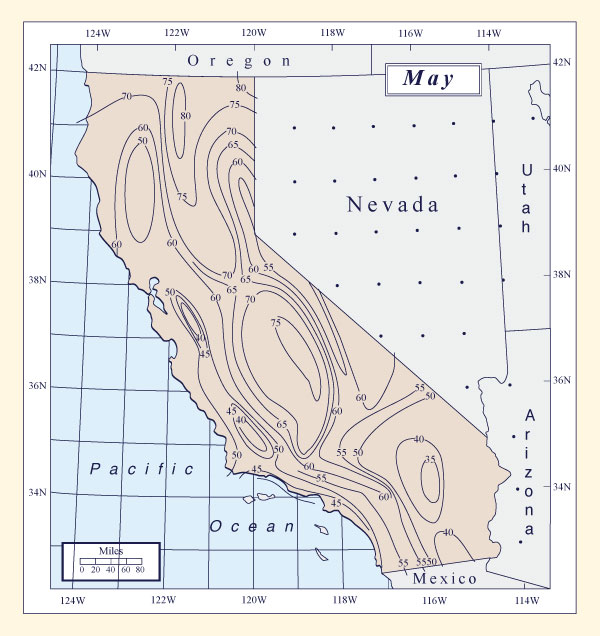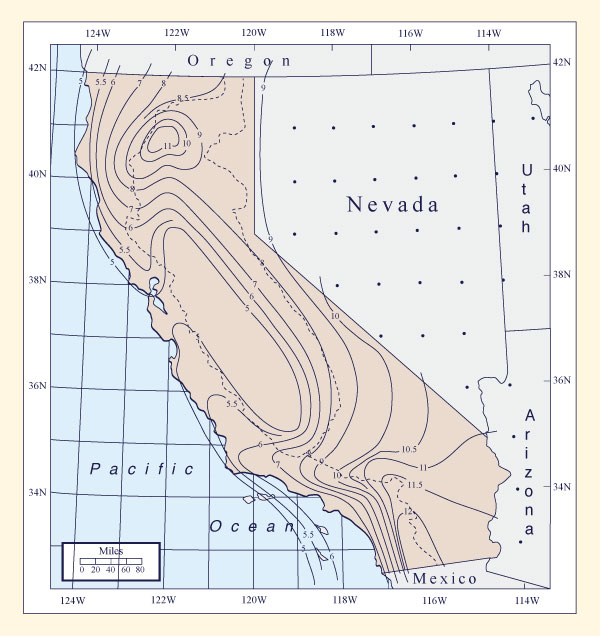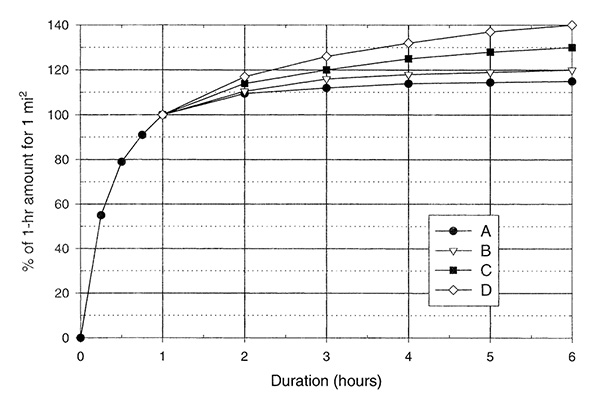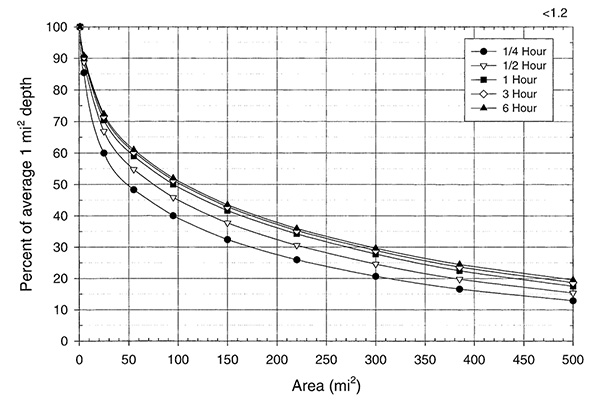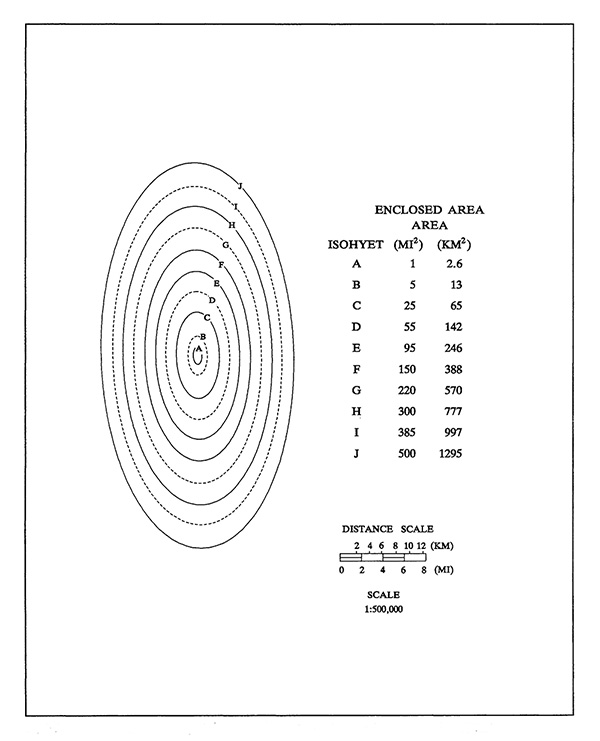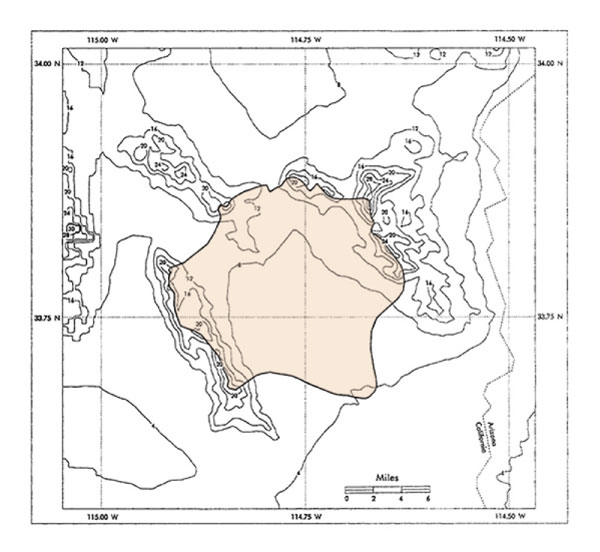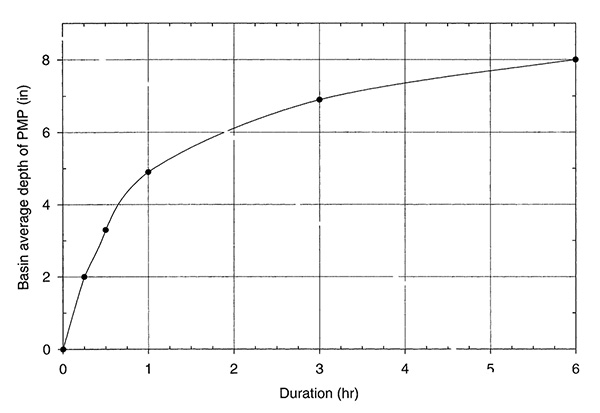|
|
|
CHAPTER 14: HYDROLOGIC DESIGN CRITERIA |
|
"Water will dissolve almost anything to some degree. The dissolved material tends to remain is solution because of water's extreme dielectric constant, which is greater than for any other substance." Howard L. Penman (1970) |
|
This chapter describes selected design criteria and procedures used by U.S. federal agencies. This information is intended to complement the subjects presented in Chapters 4 to 13. |
The techniques of hydrologic analysis described in Chapters 4-13 are useful in hydrologic design and hydrologic forecasting. In hydrologic design, the objective is to predict the behavior of hydrologic variables under a hypothetical extreme condition such as the 100-y flood or the probable maximum flood. In hydrologic forecasting the aim is to predict the behavior of hydrologic variables within a shorter time frame, either daily, monthly, seasonally, or annually. These two types of hydrologic applications are quite different, paralleling the differences between event-driven and continuous-process catchment models (Section 13.1).
Hydrologic design precedes hydraulic design; i.e., the output of hydrologic design is the input to hydraulic design. Hydrologic design determines streamflows, discharges, and headwater levels, from which hydraulic design derives flow depths, velocities, and pressures acting on hydraulic structures and systems. Actual sizing of structures and appurtenances is obtained by balancing efficiency, practicality, and economy.
In practice, hydrologic design translates into hydrologic design criteria, i.e., a set of rules and procedures used by federal, state, or local agencies having cognizance with water resources projects. Of necessity, these criteria are likely to vary widely, reflecting the charter and jurisdiction of each agency, and the size and scope of individual projects.
The following federal agencies are actively engaged in developing and using hydrologic design criteria for engineering applications:
- NOAA National Weather Service
- U.S. Army Corps of Engineers
- USDA Natural Resources Conservation Service
- U.S. Bureau of Reclamation
- U.S. Geological Survey.
14.1 NATIONAL WEATHER SERVICE
|
|
Probable Maximum Precipitation
The Probable Maximum Precipitation (PMP) is the theoretically greatest depth of precipitation for a given duration that is physically possible over a given size storm area, at a particular geographical location, at a certain time of the year [7]. In view of the incomplete knowledge of meteorological processes, calculated PMP values are regarded as estimates [4]. For applications in hydraulic design, a suitable rainfall-runoff transform is used to convert the PMP into the Probable Maximum Flood (PMF).
Estimates of PMP are based on either statistical or deterministic approaches. The statistical approach is based on the analysis of time series. The deterministic approach, commonly referred to as the generalized estimate, is based on regional PMP isoline maps. In the United States, PMP determinations are commonly based on generalized estimates, using isoline maps developed by NOAA National Weather Service. The statistical approach is applicable in regions where a generalized estimate has not been developed.
Statistical Estimates of PMP. The statistical frequency formula is:
| xT = x̄n + KT sn | (14-1) |
in which xT is the rainfall associated with a return period T, x̄n and sn
are the mean and standard deviation of a series of n annual maxima, and KT is the frequency factor
associated with T (
In terms of maximum rainfall, Eq. 14-1 can be expressed as follows:
| xM = x̄n + KM sn | (14-2) |
in which xM is the maximum rainfall and KM is the number of standard deviations that must be added to the mean in order to obtain xM.
An empirical estimate of KM may be obtained by enveloping a value of KM based on a large number of computed values. The value KM = 15 was considered initially by Hershfield [1] to be an appropriate enveloping value. This analysis was based on data from 2600 stations, approximately 90% of which were located in the United States. However, Hershfield's later studies [2] have shown that KM actually varies with mean annual maximum rainfall and storm duration, as shown in Fig. 14-1. Note that this procedure gives point estimates of PMP; areal estimates may be obtained through the use of an appropriate depth-area relation.
Figure 14-1 Frequency factor KM as a function of mean annual maximum rainfall and storm duration [2]. |
The step-by-step procedure to estimate the D-hr PMP based on statistical data is the following:
Compile the D-hour annual-maxima rainfall series.
Calculate the mean and standard deviation of the D-hour annual-maxima rainfall series.
Using Fig. 14-1, determine the value of KM as a function of mean annual maximum rainfall and D-hour duration.
Using Eq. 14-2, calculate the D-hour point PMP.
For basins in excess of 25 km2, determine the areal PMP by reducing the point PMP using an appropriate depth-area relation.
Generalized Estimates of PMP. The procedure for determining generalized estimates of PMP varies from nonorographic to orographic regions. For nonorographic regions, the approach consists of performing three operations on observed areal storm precipitation: (1) moisture maximization, (2) transposition, and (3) envelopment. Moisture maximization consists of increasing the storm precipitation to a value that is consistent with the maximum moisture in the atmosphere, for the given storm's geographical location and month of occurrence.
Transposition involves the relocation of storm precipitation within a meteorologically homogeneous region, thereby increasing the quantity of data available for the evaluation of precipitation potential. Envelopment consists of the smooth interpolation between maxima for different durations and areas. In many cases, enveloping curves may increase the values of PMP obtained using only maximization and transposition. Envelopment also produces smooth geographical variations, assuring the consistency of mapped values.
For orographic regions, terrain plays an important role in precipitation, acting both to increase or reduce observed rainfall. Thus, orographic effects from storm-terrain interactions have a bearing on PMP determinations.
In the United States,
the National Oceanic and Atmospheric Administration's (NOAA) National Weather Service (NWS) is
responsible for the development of generalized estimates of probable maximum precipitation (PMP).
The concepts and related methodologies are described in the NOAA NWS Hydrometeorological Report (HMR) series.
Reports of current applicability are listed in
Figure 14-2 Regions covered by HMR reports (Click on the figure to enlarge). |
Figure 14-1 shows the following:
HMR 49 applies for the Colorado River and Great Basin drainages.
HMR 51, 52 and 53 apply for regions east of the 105th meridian, i.e., the U.S. East and Midwest, including the central states.
HMR 55A applies for the United States between the Continental Divide and the 103rd meridian (Note the overlap with HMR 51, 52, and 53).
HMR 57 applies for the Pacific Northwest states and Pacific Coastal drainages.
HMR 58 and 59 apply for the state of California.
Other HMR reports apply for smaller regional areas, including Hawaii, Alaska, and Puerto Rico.
PMP Estimates for Regions East of the 105th Meridian.
Procedures for estimating PMP
in
Figure 14-3 All-season PMP (in.) for 24-h 10-mi2 rainfall (Click on the figure to enlarge) [4]. |
Generalized PMP estimates can be obtained by the following steps, as explained in HMR 51 [4]:
Determine the geographical location and area of the drainage basin under study.
Using the maps in HMR 51, prepare a table of PMP depths applicable to the given geographical location. Use the maps of all five (5) durations and of at least four (4) areas comprising the drainage basin size of interest. For instance, for a basin size of 11,300 mi2, tabulate 5 × 4 =
20 PMP depths (obtained from the 6-, 12-, 24-, 48-, and 72-hr maps, and from the 1000-, 5000-, 10,000-, and 20,000-mi2 area maps).For each of five (5) durations (6-, 12-, 24-, 48-, and 72-hr), plot PMP depths versus basin area on semilogarithmic paper, with PMP depth in the abscissas (arithmetic scale) and basin area in the ordinates (logarithmic scale), to obtain a PMP depth-area-duration (DAD) relation.
Using the PMP DAD relation developed in step 3, determine, for the given basin area, the applicable PMP depth for each of five (5) durations.
Plot PMP depth versus duration on arithmetic scales and draw a smooth curve connecting these points, to determine the PMP depth-duration relation for the given basin area size and geographical location.
Determine the 6-h incremental PMP depths using the PMP depth-duration relation developed in step 5. The 6-h incremental PMP is the PMP expressed in 6-h increments. This is accomplished by calculating the PMP depth for successive durations in multiples of 6 h, and subtracting two consecutive PMP depths to determine an incremental PMP value. For instance, the difference between the 24- and 18-h PMP depth is the 6-h incremental PMP depth associated with the 18- to 24-h time interval.
The application of HMR 51 to specific drainage basins, including the temporal and spatial distribution of the probable maximum storm is described in HMR 52 [5].
PMP Estimates for Regions West of the Continental Divide. The procedures for estimating PMP for U.S. regions west of the Continental Divide are described in the following HMR reports:
HMR 49: Colorado River and Great Basin drainages [3],
HMR 57: Pacific Northwest States) [8], and
HMR 58 and HMR 59: California [9, 10].
Unlike the case of the U.S. regions east of the 105th meridian, in regions west of the Continental Divide, the local storm (thunderstorm) is not enveloped with general-storm depth-duration data.
The estimates of local-storm PMP comprise durations varying from 15 minutes to 6 hours, and drainage areas between 1 and 500 mi2 (2.59 and 1,295 km2). Local-storm PMP is applicable to the warm season, between May and October.
PMP Estimates for California.
The procedures for estimating PMP in California are
described in HMR 58 and HMR 59 [9, 10]. Note that HMR 58 is contained in HMR 59.
HMR 58 provides estimates of general-storm PMP for a given drainage area, for durations
of
In HMR 58, the local-storm PMP comprises durations varying from 15 minutes to 6 hours, and drainage areas between 1 and 500 mi2 (2.59 and 1,295 km2). For basins less than 500 mi2, it is necessary to calculate both general- and local-storm PMP. The larger of these estimates is the applicable PMP for the given basin.
General-Storm PMP Computation for California. The procedure for estimating a general-storm all-season PMP in California is the following:
Basin location
Find the geographical location of the basin of interest.
Evaluate the basin outline and its drainage area.
All-season PMP index estimate [10-mi2 24-h ]
Overlay the drainage area on the appropriate general-storm PMP index map.
Two maps are provided in HMR 59 [10]: California-South, also shown here asFig. 14-4 (a); and California-North, also shown here asFig. 14-4 (b). Cover the entire drainage area with a uniform grid.
Determine the average general-storm PMP index [10-mi2 24-h] applicable to the entire drainage area.
Depth-duration ratios and 10-mi2 PMP depths
Locate the basin within one of the regions of California shown in Fig. 14-5. Note that occasionally the basin may subtend more than one region.
Use Table 14-2 to determine the appropriate all-season PMP depth-duration ratios. Use proportionally region-weighted values if more than one subregion is subtended by the basin.
Multiply the depth-duration ratios (obtained in Step 3b) by the average general-storm PMP index [10-mi2 24-h] (obtained in Step 2c) to calculate 10-mi2 PMP depths for durations of 1, 6, 12, 24, 48, and 72 h.
Table 14-2. California all-season PMP depth-duration ratios.* No. Region Duration (h) 1 6 12 24 12 24 1 Northwest 0.10 0.40 0.73 1.00 1.49 1.77 2 Northeast 0.16 0.52 0.69 1.00 1.40 1.55 3 Midcoastal 0.13 0.45 0.74 1.00 1.45 1.70 4 Central Valley 0.13 0.42 0.65 1.00 1.48 1.75 5 Sierra 0.14 0.42 0.65 1.00 1.56 1.76 6 Southwest 0.14 0.48 0.76 1.00 1.41 1.59 7 Southeast 0.30 0.60 0.86 1.00 1.17 1.28 * This table is the same as Table 2.1 of HMR 58. Areal reduction factors
With the appropriate region known (Fig. 14-5), use one of Figs. 14-6 (a) to 14-6 (f) t obtain, for each of six (6) storm durations (1, 6, 12, 24, 48, and 72 h), the applicable all-season percent areal reduction.
Multiply the PMP depths (calculated in Step 3c) by the percent areal reductions (obtained in Step 4a) and divide by 100 to obtain the area-reduced PMP depths.
Incremental PMP values
Plot the results of Step 4b on an arithmetic graph and draw a smooth curve.
Obtain cumulative 6-h PMP values.
Each discrete 6-h PMP incremental value is the difference between two consecutive cumulative values.
Temporal distribution of PMP
To provide the most critical 72-h PMP storm sequence, group the four heaviest 6-h incremental values in a 24-h sequence, as follows:
Place the second highest value next to the highest, to provide the most critical 12-h sequence;
Place the third highest on either side of the 12-h sequence, to provide the most critical 18-h sequence, and
Place the fourth highest on either side of the 18-h sequence.
The 24-h heaviest sequence may be positioned anywhere in the 72-h period. The remaining eight 6-h amounts may be positioned anywhere else. For PMF purposes, critical PMP sequences are usually obtained by trial and error.
Spatial distribution of PMP
There are no fixed rules to develop a spatial storm pattern for general-storm PMP determinations. In the absence of local data, established NOAA National Weather Service isopercental curves may be used.
A spatial storm pattern for PMP may also be based on a significant storm with a sufficient number of observations. However, only a few California storms have sufficient detail to define a storm pattern.
Figure 14-4 (a)
General-storm PMP Index map for California - South |
Figure 14-4 (b)
General-storm PMP Index map for California - North |
Figure 14-5
Regional boundaries for the development of depth-duration ratios in California |
Figure 14-6 (a)
Depth-area-duration relation for the Northwest-Northeast region of California |
Figure 14-6 (b)
Depth-area-duration relation for the Midcoastal region of California |
Figure 14-6 (c)
Depth-area-duration relation for the Central Valley region of California |
Figure 14-6 (d)
Depth-area-duration relation for the Sierra region of California |
Figure 14-6 (e)
Depth-area-duration relation for the Southeast region of California |
Figure 14-6 (f)
Depth-area-duration relation for the Southwest region of California |
Example of General-Storm PMP Computation for California. The Auburn Dam drainage basin above Folsom Lake, California, is used as an example of a general-storm PMP computation. This example is described in HMR 58 [9] (Fig. 14-7).
Figure 14-7
Delineation of Auburn dam drainage basin on the general-storm PMP index map |
The following steps are used to calculate the all-season PMP:
Basin location
The basin is located in Region 5 Sierra of California-North PMP index map, as shown in Fig. 14-5.
The drainage area is 973 mi2.
All-season PMP index estimate [10-mi2 24-h]
The average general-storm PMP index within the drainage area shown in Fig. 14-7 is calculated to be equal to
24.6 mi2. Depth-duration ratios and 10-mi2 PMP depths
The Auburn drainage basin is within Region 5 (Sierra), except for a very small portion near the damsite, which may be regarded as inconsequential (Fig. 14-5). Table 14-3 shows the applicable depth-duration ratios, extracted from Table 14-2.
Table 14-3. All-season PMP depth-duration ratios for the Sierra region. No. Region Duration (h) 1 6 12 24 12 24 5 Sierra 0.14 0.42 0.65 1.00 1.56 1.76 Table 14-4 shows the all-season 10-mi2 PMP depths, obtained by multiplying the average
[10 mi2 24-h] PMP index value of 24.6 in (obtained in Step 2) times each one of the depth-duration ratios shown in Table 14-3.Table 14-4. All-season 10-mi2 PMP depths (in) for the Auburn drainage. No. Region Duration (h) 1 6 12 24 12 24 5 Sierra 3.44 10.3 16.0 24.6 38.4 43.3 -
Areal reduction factors
Use Fig. 14-6 (d) (Sierra) to determine all-season areal reduction factors for each of six (6) storm durations: 1, 6, 12, 24, 48, and 72 h. The areal reduction factors are shown in Table 14-5.
Table 14-5. All-season areal reduction factors for the Auburn drainage. Drainage area
(mi2)Duration (h) 1 6 12 24 12 24 973 0.64 0.67 0.70 0.72 0.77 0.80 Multiply the all-season 10-mi2 PMP depths shown in Table 14-4 times the corresponding area reduction factors shown in Table 14-5 to obtain the all-season PMP depth-duration results shown in Table 14-6.
Table 14-6. All-season PMP depth-duration for the Auburn drainage. Duration (h) 1 6 12 24 12 24 PMP depth (in) 2.2 6.9 11.2 17.7 29.6 34.6 Incremental PMP values
Figure 14-8 shows depth-duration curves for the all-season PMP depths shown in
Table 14-6. The All-season PMP is shown as a solid line. Also shown in the seasonal PMP (May), calculated in the seasonal PMP section (next section).Table 14-7 shows the 6-h cumulative all-season PMP depths obtained from Fig. 14-7.
Table 14-8 shows the 6-h incremental all-season PMP depths obtained from Table 14-7.Table 14-7. 6-h cumulative all-season PMP depths for the Auburn drainage. Duration (h) 6 12 18 24 30 36 42 48 54 60 66 72 PMP (in) 6.9 11.2 14.6 17.7 20.8 23.8 26.7 29.6 31.6 32.7 33.7 34.6 Table 14-8. 6-h incremental all-season PMP depths for the Auburn drainage. Duration (h) 6 12 18 24 30 36 42 48 54 60 66 72 PMP (in) 6.9 4.3 3.4 3.1 3.1 3.0 2.9 2.9 2.0 1.1 1.0 0.9 Temporal distribution of PMP
Using the rules for temporal distribution of PMP, a possible 72-h storm sequence, in 6-h increments, is selected. Table 14-9 shows the chosen sequence.
Table 14-9. Possible all-season 72-h PMP storm for the Auburn drainage, in 6-h increments. Duration (h) 6 12 18 24 30 36 42 48 54 60 66 72 PMP (in) 3.1 3.0 2.9 2.9 3.1 4.3 6.9 3.4 1.1 0.9 2.0 1.0
Figure 14-8 Depth-duration curves for the Auburn dam drainage basin (Click on the figure to enlarge) [9]. |
Example of Seasonal-Storm PMP Computation for California. The following example describes a seasonal-storm PMP computation for California. The procedure is for the month of May for the Auburn drainage (Fig. 14-7).
The all-season PMP index value, calculated in the previous section, is 24.6 in.
Figure 14-9 shows
the variation of general-storm PMP for the month of May, as a percent of all-season PMP.
By placing the Auburn drainage (Fig. 14-7) in its geographical location in Fig. 14-9, a value of 68% for the Auburn drainage is obtained (See
Note below).
Therefore,
the average PMP depth for the Auburn drainage for the month of May is:
Note: A complete set of 10-mi2 general-storm PMP for each month of the year, as a percent of all-season PMP, is given in |
Figure 14-9 10-mi2 24-h general-storm PMP for the month of May, as a percent |
Examination of the general-storm monthly PMP maps shows that the nearest all-season month
for the Auburn drainage location is March, and the monthly offset is 2 (May to March, i.e., two-months difference).
Table 14-10 shows the seasonally adjusted 2-month-offset
|
Table 14-10. Seasonally adjusted 2-month-offset 10-mi2 PMP depth-duration ratios for the Sierra region.* | ||||||||
| No. | Region | Offset (months) |
Duration (h) | |||||
| 1 | 6 | 12 | 24 | 12 | 24 | |||
| 5 | Sierra | 2 | 0.148 | 0.437 | 0.663 | 1.000 | 1.451 | 1.549 |
|
* These values were obtained from the appropriate line of
|
||||||||
Table 14-11 shows the seasonally adjusted May 10-mi2 PMP,
obtained by multiplying the calculated PMP depth for the month of May (16.7 in) by each one of the depth-duration ratios shown in
| Table 14-11. Seasonally adjusted May 10-mi2 PMP for the Auburn drainage. | ||||||||
| No. | Region | Offset (months) |
Duration (h) | |||||
| 1 | 6 | 12 | 24 | 12 | 24 | |||
| 5 | Sierra | 2 | 2.5 | 7.3 | 11.1 | 16.7 | 24.2 | 25.9 |
Table 14-12 shows the seasonally adjusted areal reduction factors for the Sierra region, 2-month offset.
|
Table 14-12. Seasonally adjusted areal reduction factors for the Auburn drainage, 2-month offset.* | |||||||
| Drainage area
(mi2) |
Duration (h) | ||||||
| 1 | 6 | 12 | 24 | 12 | 24 | ||
| 973 | 0.548 | 0.607 | 0.648 | 0.687 | 0.731 | 0.773 | |
| * These values were obtained from the appropriate line of Table 2.7 of HMR 58, by interpolation to 973 mi2. The complete set of tables of seasonally adjusted areal reduction factors is given in Tables 2.4 to 2.9 of HMR 58. | |||||||
Table 14-13 shows the seasonally adjusted May PMP for the Auburn drainage, obtained by multiplying the seasonally adjusted May 10-mi2 PMP values shown in Table 14-11
times the corresponding areal reduction factors shown in
| Table 14-13. Seasonally adjusted May PMP depth-duration for the Auburn drainage. | ||||||
| Duration (h) | 1 | 6 | 12 | 24 | 12 | 24 |
| PMP depth (in) | 1.4 | 4.4 | 7.2 | 11.5 | 17.7 | 20.0 |
The seasonally adjusted May PMP depth-duration results shown in Table 14-13 are plotted in
|
Table 14-14. 6-h cumulative seasonally adjusted (May) PMP depths for the Auburn drainage. | ||||||||||||
| Duration (h) | 6 | 12 | 18 | 24 | 30 | 36 | 42 | 48 | 54 | 60 | 66 | 72 |
| PMP (in) | 4.4 | 7.2 | 9.4 | 11.5 | 13.3 | 15.0 | 16.4 | 17.7 | 18.5 | 19.1 | 19.6 | 20.0 |
Table 14-15 shows the 6-h incremental seasonally adjusted (May) PMP depths obtained from Table 14-14.
| Table 14-15. 6-h incremental seasonally adjusted (May) PMP depths for the Auburn drainage. | ||||||||||||
| Duration (h) | 6 | 12 | 18 | 24 | 30 | 36 | 42 | 48 | 54 | 60 | 66 | 72 |
| PMP (in) | 4.4 | 2.8 | 2.2 | 2.1 | 1.8 | 1.7 | 1.4 | 1.3 | 0.8 | 0.6 | 0.5 | 0.4 |
Using the rules for temporal distribution of PMP, a possible 72-h storm sequence, in 6-h increments, is selected. Table 14-16 shows the chosen sequence.
| Table 14-16. Possible seasonally adjusted (May) 72-h PMP storm for the Auburn drainage, in 6-h increments. | ||||||||||||
| Duration (h) | 6 | 12 | 18 | 24 | 30 | 36 | 42 | 48 | 54 | 60 | 66 | 72 |
| PMP (in) | 0.6 | 0.8 | 2.2 | 4.4 | 2.8 | 2.1 | 1.8 | 1.7 | 1.4 | 1.3 | 0.5 | 0.4 |
Local-Storm PMP Computation for California. There are two procedures to calculate the local-storm PMP for California:
Average depth, and
Spatially distributed depth.
The PMP calculated using the average-depth method is usually greater than that calculated using the spatially distributed method.
The following steps are used to calculate the local-storm PMP:
1-h 1-mi2 local-storm PMP index
Determine a 1-h 1-mi2 local-storm PMP index by overlaying the watershed of interest on the map shown in
Fig. 14-10. Use linear interpolation.
Mean basin elevation adjustment
Determine the mean basin elevation. No adjustment is necessary for elevations less than or equal to 6,000 ft.
For elevations greater than 6,000 ft, reduce the PMP index depth obtained in Step 1a by 9% for every 1,000 ft above the 6,000 ft threshold. For example, for the elevation of 8,700 ft, the adjustment is: [(8,700 - 6,000)/1000] × 9% = 24.3%, rounded to 24%. Therefore, the elevation-adjusted PMP is: PMP ×
(100 - 24)/100 = (0.76) PMP.
Storm duration adjustment
The 1-mi2 local-storm PMP for durations less than 1 hour are obtained from Fig. 14-11 as a percentage of the 1-h 1-mi2 local-storm PMP index obtained in Step 1a.
The 1-mi2 local storm PMP for durations greater than 1 h is calculated as follows:
Locate the basin in Fig. 14-12 and determine the ratio of 6-h to 1-h local-storm PMP from the map, for example 1.15;
The values shown in Fig. 14-12 are labeled type curve A (1.15), B (1.2), C (1.3), or D (1.4);
Enter Fig. 14-11 for the chosen type curve (A, B, C, or D) to obtain the percentage of the 1-h 1-mi2 local-storm PMP index for durations greater than 1 h, up to 6 h.
-
Areal reduction factors
Figure 14-13 shows the California 1-mi2 local-storm depth-area relation for a 6-h to 1-h depth-duration adjustment ratio less than 1.2 (< 1.2). If this is the case, enter Fig. 14-13 with the basin area in the abscissas to the curve for the respective duration (1/4-h to 6-h) to determine the percent of 1-mi2 depth in the ordinates.
A complete set of California 1-mi2 local-storm depth-area relations for all four values of 6-h to 1-h depth-duration adjustment ratios (< 1.2, 1.2, 1.3, and 1.4) is given in California local-storm depth-area relations.
Temporal storm distribution
The review of local-storm temporal distributions for California shows that most storms have durations less than 6 h and that the greatest 1-h amount occurs in the first hour. The recommended sequence of hourly increments is as follows:
Obtain the hourly increments by successive subtraction from the smoothed depth-duration curve (Fig. 4-10) or from Table 4-17.
Arrange the hourly increments from largest to smallest: the most intense 1-h increment occurs in the first hour, the second most intense occurs in the second hour, and so forth.
Table 14-17. Depth-duration relations (in percent of 1-h amounts)
applicable to 1-mi2 local-storm PMP in California.Duration
(h)A B C D 0 0 0 0 0 1/4 55 55 55 55 1/2 79 79 79 79 3/4 91 91 91 91 1 100 100 100 100 2 109.5 110.5 114 117 3 112 116 120 126 4 114 118 125 132 5 114.5 119 128 137 6 115 120 130 140 Areal distribution of local-storm PMP
Figure 4-14 shows an idealized isohyetal pattern for local-storm PMP areas up to 500-mi2. The elliptical lettered pattern (A-J) of Fig. 4-13 and the tabulated percentages in
HMR 58 Table 2.11 (ratio < 1.2),Table 2.12 (ratio = 1.2), Table 2.13 (ratio = 1.3), andTable 2.14 (ratio = 1.4) are used to describe the areal distribution of precipitation of a local-storm PMP. [These HMR 58 tables are given in HMR 58 local-storm areal distribution tables].The 2:1 ratio of the major to minor axis of Fig. 14-14 should be placed only on a map at 1:500,000 scale.
The average index value from Step 2a or 2b is multiplied times each of the percentages from the appropriate HRM 58 local-storm areal distribution tables to obtain the value for each lettered isohyet (A-J).
Once the labels have been determined for each application, the pattern can be moved to different placements on the basin.
In most instance, the greatest volume of precipitation will be obtained when the pattern is centered in the drainage. However, peak flows may actually occur with placements closer to the drainage outlet.
Figure 14-10 California 1-h 1-mi2 local-storm PMP index map |
Figure 14-11 California 1-mi2 local-storm depth-duration relations |
Figure 14-12 California 1-mi2 local-storm depth-duration adjustment ratios |
Figure 14-13 California 1-mi2 local-storm depth-area relation |
Figure 14-14 Idealized isohyetal pattern for local-storm PMP for areas up to 500-mi2 |
Example of Local-Storm PMP Computation for California. An example of local-storm PMP computation is described here. The selected basin is McCoy Wash, a small 176-mi2 drainage located in southeastern California. This example is taken from HMR 58 [9].
Figure 14-15 shows the geographical location of the basin. Superposition of the basin outline on
Figure 14-15 Drainage area of McCoy Wash,
in Southeastern California, with elevation contours |
From Fig. 14-12, the applicable adjustment ratio for the given geographical location is 1.3 (curve C in Fig. 14-11). Table 14-18 shows the depth-duration adjustment ratios and the corresponding local-storm 1-mi2 PMP values adjusted for duration.
| Table 14-18. 1-mi2 local-storm PMP depth-duration for the McCoy Wash drainage. | |||||||||
|
Duration (h) |
1/4 | 1/2 | 3/4 | 1 | 2 | 3 | 4 | 5 | 6 |
| Adjustment ratio * | 0.55 | 0.79 | 0.91 | 1.00 | 1.14 | 1.20 | 1.25 | 1.28 | 1.30 |
| PMP (in) |
6.3 | 9.0 | 10.4 | 11.4 | 13.0 | 13.7 | 14.3 | 14.6 | 14.8 |
| * These values correspond to those of curve C, Fig. 14-10. | |||||||||
Figure 2-27 of HMR 58 (California local-storm depth-area relations) shows the depth-area relations for a California local-storm PMP for a 1-mi2 6-h to 1-h depth-duration adjustment ratio equal to 1.3 (curve C).
Table 14-19 shows the area-reduced 167-mi2 local-storm PMP depth-duration for the McCoy Wash drainage.
For each duration, the PMP values shown in
Table 14-19 were obtained by multiplying the corresponding PMP value of Table 14-18 (for instance, 11.4 for 1 h) times
the
(percent of 1-mi2)/100 (that is, 0.43 for 1 h) shown in Table 14-19.
Thus, for 1-h duration, the local-storm 167-mi2 PMP is:
| Table 14-19. 167-mi2 local-storm PMP depth-duration for the McCoy Wash drainage. | |||||||||
| Duration (h) | 1/4 | 1/2 | 1 | 3 | 6 | ||||
| (Percent of 1-mi2) /100 * | 0.31 | 0.37 | 0.43 | 0.50 | 0.54 | ||||
| PMP (in) | 2.0 | 3.3 | 4.9 | 6.9 | 8.0 | ||||
| * These values are taken from Fig 2-27 [HMR 58] by interpolation to 167-mi2. | |||||||||
Figure 14-16 Average depth of local-storm PMP
for the 167-mi2 McCoy Wash, California |
Table 14-20 shows the 167-mi2 local-storm PMP for the McCoy Wash drainage. The cumulative PMP values are obtained from Fig. 14-16 at every hourly interval. The incremental PMP values are obtained by successive subtraction of the respective cumulative values. The highest-to-lowest increment sequence shown in Table 14-20 is the recommended one for the local-storm PMP.
| Table 14-20. 167-mi2 local-storm PMP for the McCoy Wash drainage. | ||||||
| Duration (h) | 1 | 2 | 3 | 4 | 5 | 6 |
| Cumulative PMP (in) | 4.9 | 6.1 | 6.9 | 7.4 | 7.7 | 8.0 |
| Incremental PMP (in) | 4.9 | 1.2 | 0.8 | 0.5 | 0.3 | 0.3 |
The areal distribution of PMP isohyets is shown in Fig. 14-14.
This elliptical lettered pattern (A-J) comprises an area of 500 mi2, at a scale of
1:500,000. For this example (McCoy Wash), the percentages
from Table 2.13 of HMR 58 apply, i.e., for a basin with a
6-h to 1-h ratio of 1.3 (curve C).
For completeness, Table 2-13 of HMR 58
is repeated here as
| Table 14-21. Isohyetal label values,
in percent of 1-mi2 1-h local-storm PMP, corresponding to curve C of Fig. 14-10. | ||||||||||
|
Isohyetal tag |
Area (mi2) |
Duration (h) | ||||||||
| 1/4 | 1/2 | 3/4 | 1 | 2 | 3 | 4 | 5 | 6 | ||
| A | 1 | 55 | 79 | 91 | 100 | 114 | 120 | 125 | 128 | 130 |
| B | 5 | 44 | 66 | 77.6 | 86 | 100 | 106 | 111 | 114 | 116 |
| C | 25 | 26 | 44 | 53.6 | 61 | 74 | 81 | 86 | 89 | 91 |
| D | 55 | 17 | 31 | 40.2 | 46.5 | 58 | 65 | 70 | 73 | 75 |
| E | 95 | 11 | 20 | 26.8 | 32.5 | 42 | 49 | 54 | 57 | 59 |
| F | 150 | 6.6 | 13 | 19 | 24 | 32 | 38 | 43 | 46 | 48 |
| G | 220 | 6.5 | 11 | 14 | 16 | 23 | 28 | 33 | 36 | 38 |
| H | 300 | 5 | 8 | 10.5 | 12 | 17.5 | 21.5 | 25.5 | 29 | 31 |
| I | 385 | 3 | 6 | 8.5 | 10.5 | 16 | 20 | 24 | 27.5 | 30 |
| J | 500 | 2.5 | 5.5 | 8 | 10 | 15 | 19 | 23 | 26.5 | 29 |
Table 14-22 shows the isohyetal label values for local-storm PMP for the McCoy drainage. Values in this table were obtained by multiplying 11.4 in, corresponding to the 1-mi2 1-h PMP depth, times each one of the values of Table 14-21.
For comparison, the spatially averaged 6-h PMP for the 167-mi2 McCoy Wash is 8 in (Table 14-19).
On the other hand, from Table 14-22, for a 6-h PMP, the isohyetal labels range from 14.82 inches
| Table 14-22. Isohyetal label values for local-storm PMP for the McCoy Wash drainage (167 mi2). | ||||||||||
|
Isohyetal tag |
Area (mi2) |
Duration (h) | ||||||||
| 1/4 | 1/2 | 3/4 | 1 | 2 | 3 | 4 | 5 | 6 | ||
| A | 1 | 6.27 | 9.01 | 10.37 | 11.40 | 13.00 | 13.68 | 14.25 | 14.59 | 14.82 |
| B | 5 | 5.02 | 7.52 | 8.85 | 9.80 | 11.40 | 12.08 | 12.65 | 13.00 | 13.22 |
| C | 25 | 2.96 | 5.02 | 6.11 | 6.95 | 8.44 | 9.23 | 9.80 | 10.15 | 10.37 |
| D | 55 | 1.94 | 3.53 | 4.58 | 5.30 | 6.61 | 7.41 | 7.98 | 8.32 | 8.55 |
| E | 95 | 1.25 | 2.28 | 3.06 | 3.71 | 4.79 | 5.59 | 6.16 | 6.50 | 6.72 |
| F | 150 | 0.75 | 1.48 | 2.17 | 2.74 | 3.65 | 4.33 | 4.90 | 5.24 | 5.47 |
| G | 220 | 0.74 | 1.25 | 1.60 | 1.82 | 2.62 | 3.19 | 3.76 | 4.10 | 4.33 |
| H | 300 | 0.57 | 0.91 | 1.20 | 1.37 | 2.00 | 2.45 | 2.91 | 3.31 | 3.53 |
| I | 385 | 0.34 | 0.68 | 0.97 | 1.20 | 1.82 | 2.28 | 2.74 | 3.14 | 3.42 |
| J | 500 | 0.29 | 0.63 | 0.91 | 1.14 | 1.71 | 2.17 | 2.62 | 3.02 | 3.31 |
Note that the isohyetal storm pattern of Fig. 14-14 will produce the spatially averaged PMP depth only if the basin under consideration is of elliptical shape, with a 2:1 ratio of the major to minor axis, and the ellipses are centered in a "perfect" drainage. When placed on an irregularly shaped drainage, the isohyetal storm pattern of Fig. 14-14 will produce an average depth which is less than the spatially averaged PMP depth. In this case, the spatially averaged PMP depth should be used, and the isohyetal pattern is interpreted as a guide to a possible spatial distribution of the local-storm PMP.
14.2 ARMY CORPS OF ENGINEERS
|
|
The
14.3 NATURAL RESOURCES CONSERVATION SERVICE
|
|
All
14.4 BUREAU OF RECLAMATION
|
|
The
14.5 GEOLOGICAL SURVEY
|
|
The
QUESTIONS
|
|
PROBLEMS
|
|
REFERENCES
|
|
Hershfield, D. M. (1961). "Estimating the Probable Maximum Precipitation." Journal of the Hydraulics Division, ASCE, Vol. 87, No. HY5, September, 99-116.
Hershfield, D. M. (1965). "Method for Estimating Probable Maximum Precipitation." Journal of the American Waterworks Association, Vol. 57, No. 8, August, 965-972.
NOAA Hydrometeorological Report No. 49. (1984). "Probable Maximum Precipitation Estimates, Colorado River and Great Basin Drainages." Silver Spring, Maryland, 176 p.
NOAA Hydrometeorological Report No. 51. (1978). "Probable Maximum Precipitation Estimates, United States East of the 105th Meridian." Washington, DC, June, 100 p.
NOAA Hydrometeorological Report No. 52. (1982). "Application of Probable Maximum Precipitation Estimates - United States East of the 105th Meridian." Washington, DC, August, 182 p.
NOAA Hydrometeorological Report No. 53. (1980). "Seasonal Variation of 10-mi2 Probable Maximum Precipitation Estimates, United States East of the 105th Meridian." Silver Spring, Maryland, April, 96 p.
NOAA Hydrometeorological Report No. 55A. (1988). "Probable Maximum Precipitation Estimates, United States Between the Continental Divide an the 103rd Meridian." Silver Spring, Maryland, June, 280 p.
NOAA Hydrometeorological Report No. 57. (1994). "Probable Maximum Precipitation - Pacific Northwest States, Columbia River (including portions of Canada), Snake River, and Pacific Coastal Drainages." Silver Spring, Maryland, October, 353 p.
NOAA Hydrometeorological Report No. 58. (1998). "Probable Maximum Precipitation for California - Computational Procedures." Silver Spring, Maryland, October, 106 p.
NOAA Hydrometeorological Report No. 59. (1999). "Probable Maximum Precipitation for California." Silver Spring, Maryland, February, 419 p.
| http://engineeringhydrology.sdsu.edu |
|
1505067 06:30 |
